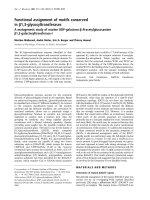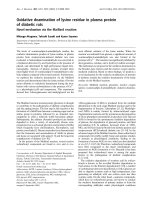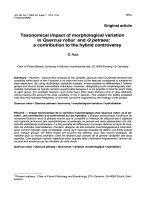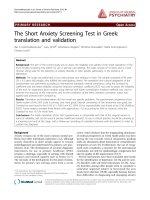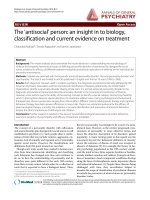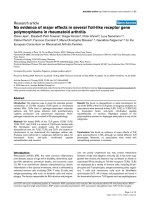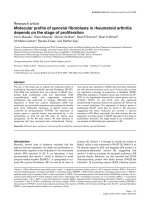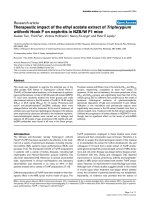Báo cáo y học: "The impact of delirium on the prediction of in-hospital mortality in intensive care patient" pptx
Bạn đang xem bản rút gọn của tài liệu. Xem và tải ngay bản đầy đủ của tài liệu tại đây (308.79 KB, 5 trang )
RESEARC H Open Access
The impact of delirium on the prediction of
in-hospital mortality in intensive care patients
Mark van den Boogaard
1*†
, Sanne AE Peters
2†
, Johannes G van der Hoeven
1
, Pieter C Dagnelie
2
, Pieter Leffers
2
,
Peter Pickkers
1
, Lisette Schoonhoven
3
Abstract
Introduction: Predictive models, such as acute physiology and chronic health evaluation II (APACHE-II), are widely
used in intensive care units (ICUs) to estimate mortality. Although the presence of delirium is associated with a
higher mortality in ICU patients, delirium is not part of the APACHE-II model. The aim of the current study was to
evaluate whether delir ium, present within 24 hours after ICU admission, improves the predictive value of the
APACHE-II score.
Methods: In a prospective cohort study 2116 adult patients admitted between February 2008 and February 2009
were screened for delirium with the confusion assessment method-ICU (CAM-ICU). Exclusion criteria were sustained
coma and unable to understand Dutch. Logistic regression analysis was used to estimate the predicted
probabilities in the model with and without delirium. Calibration plots and the Hosmer-Lemeshow test (HL-test)
were used to assess calibration. The discriminatory power of the models was analyzed by the area under the
receiver operating characteristics curve (AUC) and AUCs were compared using the Z-test.
Results: 1740 patients met the inclusion criteria, of which 332 (19%) were delirious at the time of ICU admission or
within 24 hours after admission. Delirium was associated with in-hospital mortality in unadjusted models, odds
ratio (OR): 3.22 (95% confidence interval [CI]: 2.23 - 4.66). The OR between the APACHE-II and in-hospital mortality
was 1.15 (95% CI 1.12 - 1.19) per point. The predictive accuracy of the APACHE-II did not improve after adding
delirium, both in the total group as well as in the subgroup without cardiac surgery patients. The AUC of the
APACHE model without delirium was 0.77 (0.73 - 0.81) and 0.78 (0.74 - 0.82) when delirium was added to the
model. The z-value was 0.92 indicating no improvement in discriminative power, and the HL-test and calibration
plots indicated no improvement in calibration.
Conclusions: Although delirium is a significant predictor of mortality in ICU patients, adding delirium as an
additional variable to the APACHE-II model does not result in an improvement in its predictive estimates.
Introduction
Predictive models are widely used in ICUs to estimate
the disease severity and estimate the risk of death or to
identify patients at high risk of dying [1]. Predictive esti-
mates are important from both a clinical and adminis-
trative perspective. These estimates can be used to
inform patients and their families about likely outcomes
[1,2], to monitor response to treatment, to guide physi-
cians in making clinical decisions [2], and to monitor or
compare the performance of different ICUs [3]. A com-
monly used prediction model in the ICU is the Acute
Physiology and Chronic Health Evaluation (APACHE)-II
[4], which is measured within 24 hours of ICU admis-
sion. Importantly, although the APACHE-II score was
developed in the early 1980s, it still represents the most
widely used predictive model to estimate in-hospital
mortality and it remains a valid measure of severity of
illness. The APACHE-II is able to correctly differentiate
between patients who are and who are not at risk of
dying in 62% to 88% of patients [5]. The Glasgow Coma
Scale is the only variable referring to brain (dys)function
in the APACHE-II score [4]. Delirium, another brain
disorder, is not included in the APACHE-II model,
* Correspondence:
† Contributed equally
1
Department of Intensive Care, Radboud University Nijmegen Medical
Centre, Nijmegen, P.O. box 9101, Nijmegen, 6500HB, the Netherlands
Full list of author information is available at the end of the article
van den Boogaard et al. Critical Care 2010, 14:R146
/>© 2010 van den Boogaard et al.; licensee BioMed Central Ltd. This is an open access article distributed under the terms of the Creative
Commons Attribution License (http://c reativecommons.org/licenses /by/2.0), which permits unrestricted use, distribution, and
reproduction in any medium, provided the original work is properly cited.
despite its high incidence rate in ICU patients and the
growing evidence of its association with poor outcomes
such as increased morbidity and mortality rates, and
prolonged length of hospital stay [6,7].
Delirium, defined as a disturbance of consciousness
and cognition that develops over a short period of time
and fluctuates over time, is induced by an underlying
physical cause such as the development of severe medi-
cal illness, co-morbidities and changes in drug use [8,9].
One-third of pa tients are delirious on initial assessment,
and the majority who develop delirium do so within
48 hours of admission [8].
Consequently, adding delirium to the existing
APACHE-II model could improve the predictive esti-
mates. However, despite the strong association between
delirium and mortality, such an association does not
necessarily imply clinical relevance or better prediction.
The aim of our study was to evaluate whether delir-
ium, if present within 24 hours after ICU admission,
improves the predictive accuracy of the APACHE-II
score of in-hospital mortality of critically ill patients.
Materials and methods
This prospective cohort study was carried out in the
Radboud University Nijmegen Medical Centre, the
Netherlands. This is a 960 bed university hospital with
33 ICU beds for adults where annually 2,000 to 2,500
(cardiothoracic surgery, neurosurgical, medical, surgical
and trauma) ICU patients are admitted. The study was
approved by the local Medical Ethical Committee, which
waived the need for informed consent becaus e no inter-
ventions were carried out.
Consecutive adult patients admitted to the ICU
between February 2008 and February 2009 were
included. Patients were excluded when they had a sus-
tained Richmond agitation sedation score (RASS) of
-4/-5, length of stay on the ICU for 12 hours or less,
had serious auditory or visual disorders, were unable to
understand Dutch, were severely mentally disabled or
suffered from receptive aphasia.
To detect delirium, all patients were screened with the
validated Dutch version of the Confusion Assessment
Method-ICU (CAM-ICU) [10]. The assessment with the
CAM-ICU was performed three times per day by well
trained ICU nurses during the patient’sentireICUstay
[11]. For this study patients were diagnosed with delir-
ium when they had a minimum of one positive CAM-
ICU screening assessment. As for the other parameters
used in the APACHE-II score, we used delirium that
occurred within 24 hours after ICU admission. Demo-
graphic, laboratory, clinical data, and hospital mortality
were collected. Naturally, various risk factors for the
development of delirium may differ between patients,
but these were not registered because the aim of the
present study was merely to investigate if the predictive
value of the APACHE-II score improved when delirium,
irrespective of its cause, was added.
As the APACHE-II was originally not validated for
cardiac surgery patients, a subgr oup analysis was also
performed without cardiac surgery patients.
Statistical analysis
Patient characteristics at baseline and the incidence of
delirium within 24 hours, and in-hospital mortality were
evaluated. Normally distributed data were tested para-
metrically using the Student’s T-test, and n ot normally
distributed data were tested non-parametrically using
the Mann-Whitney U test. The correlation between
delirium and the APACHE-II score was tested using the
Spearman’s rho. The association between delirium and
in-hospital mortality was evaluated in a univariate and
multivariate logistic regression model. The first model
consisted of patient’s overall score on all variables of the
APACHE-II score as the only predictive variable. The
second model, based on the data of the same patients,
consisted the variables of the APACHE-II score with
delirium added as a new predictor. Differences in model
performance between the APACHE-II model with and
without delirium were estimated on discrimination (area
under the receiver-oper ating-characteristic (AUC)
curve). The two AUCs were compared using the z-sta-
tistic for comparing AUCs derived from the same cases
as described by Hanley and McNeil [12]. A z-value
between -1.96 and +1.96 was con sidered as there being
no significant differences between the two AUCs and
with the most common used features on calibration
(Hosmer-Lemeshow’s goodness-of-fit and calibration
plots). A two-sided significance level of 5% and 95%
confidence intervals ( CI) were u sed for statistical infer-
ence. Statistical analysis was performed using SPSS
16.01 and MedCal c® version 11.3.1.0 (MedCalc Software,
Mariakerke, Belgium).
Results
During the study period, 2,116 patients were admitted to
the ICU of whom 376 patients were excluded, leaving
1,740 patients for outcome analysis. The main reason
for exclusion was persistent coma (36%) that made the
detection of delirium impossible. Baseline characteristics
of the included patients, with and without delirium
within 24 hours, are shown in Table 1, and baseline
characteristics of the patients, with and without cardiac
surgery patients, are shown in Table 2. A total of 332
patients (19%) were delirious, 132 at the time of admis-
sion and 200 within 24 hours after admission. The over-
all in-hospital mortality rate was 7.7%. In the non-
delirious group 80 of 1,408 patients (5.7%) died, and in
the delirious group this was 54 of 332 patients (16.2%).
van den Boogaard et al. Critical Care 2010, 14:R146
/>Page 2 of 5
The crude odds ratio (OR) of the presence of delirium
within 24 hours of ICU admission and in-hospital mor-
tality was 3.22 (95% CI: 2.23 to 4.66), and between the
APACHE-II score and in-hospital mortality was 1.15
(95% CI: 1.12 to 1.19) per APACHE-point. The AUC of
the APACHE-II model w ithout delirium was 0.77 (95%
CI: 0.73 to 0.81, standard error 0.19) and 0.78 (95% CI:
0.74 to 0.82, standard error 0.19) when delirium was
added. Comparison of the two AUCs with the Hanley
and McNeil test resulted in a z-value of 0.92 (P =0.36)
indicating that both AUCs not significant different and
that addition of delirium to the APACHE-II score does
not result in an improvement in discriminative power
(Figure 1). Calibration plots (Figure 2) and the Hosmer-
Lemeshow test (HL-test) showed a decrease of calibra-
tion after adding delirium to the APACHE-II score (HL-
test chi-square 12.38 and after adding delirium to the
APACHE-II chi-square 17.93). The Spearman’srho
Table 1 Baseline characteristics and differences of delirious (within 24 hours after ICU admission) and non-delirious
patients*
Non-delirium < 24 hours Delirium < 24 hours P-value
Age in years 61 ± 15 66 ± 14 0.11
Male, N (%) 134 (21.1) 198 (17.9) 0.08
APACHE-II score 14 ± 6 17 ± 6 0.18
Length of stay-ICU in days (median-IQR) 1 (1-3) 3 (1-9) < 0.0001
Length of stay-hospital in days (median-IQR) 8 (5-16) 15 (8-33) < 0.0001
Urgent admission, N (%) 708 (50.3) 253 (76.2) < 0.0001
ICU admission type (%):
- Surgical 910 (87.7) 127 (12.2)
- Medical 302 (70.1) 129 (29.9)
- Trauma 66 (78.6) 18 (21.4)
- Neurology/neurosurgical 130 (69.1) 58 (30.9)
Died, N (%) 80 (5.7) 54 (16.2) < 0.0001
APACHE, Acute Physiology and Chronic Health Evaluation-II; IQR, interquartile range.
* Data are presented as mean ± standard deviation, unless otherwise mentioned.
Table 2 Baseline characteristics of the patients in the total group and the subgroup without cardiac surgery patients*
Total group n = 1740 Non-cardiac surgery patients n = 881
Age in years 62 ± 14 58 ± 16
Gender M/F, N 1109/631 506/375
APACHE-II score 15 ± 5 16 ± 6.6
Length of stay-ICU in days (median-IQR)
- non delirious (within 24 hours after admission) 1 (1-3) 2 (1-7)
- delirious 3 (1-9) 3 (2-10)
Length of stay-hospital in days (median-IQR)
- non delirious (within 24 hours after admission) 8 (5-16) 14 (8-27)
- delirious 15 (8-33) 19 (10-36)
Urgent admission, N (%) 961 (55.2) 703 (82.8)
ICU admission type (%):
- Surgical 59.6 23.4
- Medical 24.8 45.9
- Trauma 4.8 9.4
- Neurology/neurosurgical 10.8 21.3
Delirium, N (%) 332/1740 (19.1) 223/881 (25.3)
- before admission 132 (7.6) 106 (12.0)
- within 24 hours after admission 200 (11.5) 117 (13.2)
Died, N (%)
- non delirious (within 24 hours after admission) 80 (5.7) 71 (10.8)
- delirious 54 (16.2) 36 (16.1)
APACHE, Acute Physiology and Chronic Health Evaluation-II; F, female; IQR, interquartile range; M, male.
* Data are presented as mean ± standard deviation, unless otherwise mentioned.
van den Boogaard et al. Critical Care 2010, 14:R146
/>Page 3 of 5
correlation between delirium and the APACHE-II score
was 0.22 (P < 0.0001). The subgroup, in which cardiac
surgery patients were excluded, consisted of 881
patients. The crude OR for delirium present within 24
hours after ICU admission and in-hospital mortality in
this subgroup was 1.59 (95% CI: 1.03 to 2.46) and for
APACHE-II and in-hospital mortality was 1.11 (95% CI:
1.08 to 1.15) per point.
Discussion
The main finding of th e present study is that, although
delirium present within 24 hours after ICU admission, is
associated with increased in-hospital mortality, adding
delirium to the APACHE-II score does not improve its
accuracy in predicting in-hospital mortality. Similar
results were obtained in a subgroup analysis of non-
cardiac surgery patients.
The availability of an easy to use instrument that
needs a limited amount of variables to predict the out-
come of ICU patients is of great importance for clinical
ICU practice. The APACHE-II score represent s such an
instrument with a moderate predictive value for in-hos-
pital mortality. Comparable with previous reports [5] we
found an AUC of the APACHE-II of 0.77. Theoreticall y,
adding a prevalent and relevant variable to the
APACHE-II score could improve its predictive value.
Delirium could represent such a variable, because it is a
frequent and serious disorder on the ICU associated
with poor patient outcome. Although our study con-
firms previous reports [6], showing that the presence of
delirium is an independent risk factor for mortality, we
demonstrate that the addition of delirium does not
improve the predictive value of the APACHE-II score.
There are several reasons why adding a new predictive
variable may not result in a better accu racy of a predic-
tive model including a low prevalence of the variable,
the absence of predictive value of this variable, and the
presence of a correlation between the predictive variable
andthevariable(s)originallyincludedinthepredictive
model (i.e. APACHE-II). We showed that prevalence
and predictive value of the presence of delirium are ade-
quate. However, although the occurrence of delirium in
critically ill patients is an independent ri sk factor for
mortality [6], we found that the APACHE-II score c or-
related significantly with the occurrence of delirium
within 24 hours. As a consequence, delirium has no
additive effect in the predictive value of the APACHE-II
score.
Importantly, our data do not exclude a possible a ddi-
tive effect of incorporating delirium in models that are
not focused on the first 24 hours of ICU stay, such as
the sequential organ failure assessment (SOFA) score.
Although there is a statistically significant association
between delirium present within 24 hours after ICU
admission and APACHE-II score, an association of 0.22
is rather low. Probably residual confounding plays an
important role. The effect of adding delirium to
dynamic predictive models such as the SOFA score,
warrants further investigations because in a substantial
part of the patients delirium is detected after the first
24 hours after ICU a dmission as a result of worsening
of their clinical situation.
Figure 1 Receiver-operating-characteristic and the area under
the curve of different prediction models with and without
delirium. APACHE-II, Acute Physiology and Chronic Health
Evaluation-II.
Figure 2 Calibrat ion plots of the APACHE-II model and of the
APACHE-II model with delirium. APACHE-II, Acute Physiology and
Chronic Health Evaluation-II.
van den Boogaard et al. Critical Care 2010, 14:R146
/>Page 4 of 5
Conclusions
An independent association was found between delirium
present within 24 hours after ICU admission and in-
hospital mortality. However, adding delirium as a pre-
dictive var iable to the AP ACHE-II score did not
improve its predictive value.
Key messages
• Delirium in ICU patients present wit hin 24 hours
after ICU admissi on, is associated with increased in-
hospital mortality.
• Adding delirium to the APACHE-II score does not
improve its accuracy in predicting in-hospital
mortality.
Abbreviations
APACHE-II: Acute Physiology and Chronic Health Evaluation-II; AUC: area
under the receiver operating characteristics curve; CAM-ICU: Confusion
Assessment Method-Intensive Care Unit; CI: confidence interval; HL-test:
Hosmer-Lemeshow test; OR: odds ratio; RASS: Richmond Agitation Sedation
Score; SOFA: Sequential Organ Failure Assessment.
Author details
1
Department of Intensive Care, Radboud University Nijmegen Medical
Centre, Nijmegen, P.O. box 9101, Nijmegen, 6500HB, the Netherlands.
2
Department of Epidemiology; NUTRIM/CAPHRI, Maastricht University, P.O.
box 5800 Maastricht, 6202AZ, the Netherlands.
3
Scientific Institute for Quality
of Healthcare, Radboud University Nijmegen Medical Centre, Nijmegen, P.O.
box 9101, Nijmegen, 6500HB, the Netherlands.
Authors’ contributions
MvdB and SP both carried out the study, the statistics and drafted the
manuscript. PD and PL participated in the statistical analysis and helped to
draft the manuscript. JvdH and PP supervised the study and helped to draft
the manuscript. LS participated in the study design, supervision and to draft
the manuscript. All authors read and approved the final manuscript.
Competing interests
The authors declare that they have no competing interests.
Received: 8 March 2010 Revised: 18 May 2010
Accepted: 3 August 2010 Published: 3 August 2010
References
1. Afessa B, Gajic O, Keegan MT: Severity of illness and organ failure
assessment in adult intensive care units. Crit Care Clin 2007, 23:639-658.
2. Harrell FE Jr, Lee KL, Mark DB: Multivariable prognostic models: issues in
developing models, evaluating assumptions and adequacy, and
measuring and reducing errors. Stat Med 1996, 15:361-387.
3. Ferreira FL, Bota DP, Bross A, Melot C, Vincent JL: Serial evaluation of the
SOFA score to predict outcome in critically ill patients. JAMA 2001,
286:1754-1758.
4. Knaus WA, Draper EA, Wagner DP, Zimmerman JE: APACHE II: a severity of
disease classification system. Crit Care Med 1985, 13:818-829.
5. Minne L, bu-Hanna A, de JE : Evaluation of SOFA-based models for
predicting mortality in the ICU: A systematic review. Crit Care 2008, 12:
R161.
6. Ely EW, Shintani A, Truman B, Speroff T, Gordon SM, Harrell FE Jr, Inouye SK,
Bernard GR, Dittus RS: Delirium as a predictor of mortality in
mechanically ventilated patients in the intensive care unit. JAMA 2004,
291:1753-1762.
7. Lin SM, Liu CY, Wang CH, Lin HC, Huang CD, Huang PY, Fang YF, Shieh MH,
Kuo HP: The impact of delirium on the survival of mechanically
ventilated patients. Crit Care Med 2004, 32:2254-2259.
8. McNicoll L, Pisani MA, Zhang Y, Ely EW, Siegel MD, Inouye SK: Delirium in
the intensive care unit: occurrence and clinical course in older patients.
J Am Geriatr Soc 2003, 51:591-598.
9. Ouimet S, Kavanagh BP, Gottfried SB, Skrobik Y: Incidence, risk factors and
consequences of ICU delirium. Intensive Care Med 2007, 33:66-73.
10. Vreeswijk R, Toornvliet A, Honing M, Bakker K, de Man T, Daas G, Spronk P,
de Jonghe JF, Kalisvaart KJ: Validation of the Dutch version of the
Confusion Assessment Method (CAM-ICU) for delirium screening in the
Intensive Care Unit. Netherlands Journal of Critical Care 2009, 13:73-78.
11. van den Boogaard M, Pickkers P, van der Hoeven H, Roodbol G, van
Achterberg T, Schoonhoven L: Implementation of a delirium assessment
tool in the ICU can influence haloperidol use. Crit Care 2009, 13:R131.
12. Hanley JA, McNeil BJ: A method of comparing the areas under receiver
operating characteristic curves derived from the same cases. Radiology
1983, 148:839-843.
doi:10.1186/cc9214
Cite this article as: van den Boogaard et al.: The impact of delirium on
the prediction of in-hospital mortality in intensive care patients. Critical
Care 2010 14:R146.
Submit your next manuscript to BioMed Central
and take full advantage of:
• Convenient online submission
• Thorough peer review
• No space constraints or color figure charges
• Immediate publication on acceptance
• Inclusion in PubMed, CAS, Scopus and Google Scholar
• Research which is freely available for redistribution
Submit your manuscript at
www.biomedcentral.com/submit
van den Boogaard et al. Critical Care 2010, 14:R146
/>Page 5 of 5
